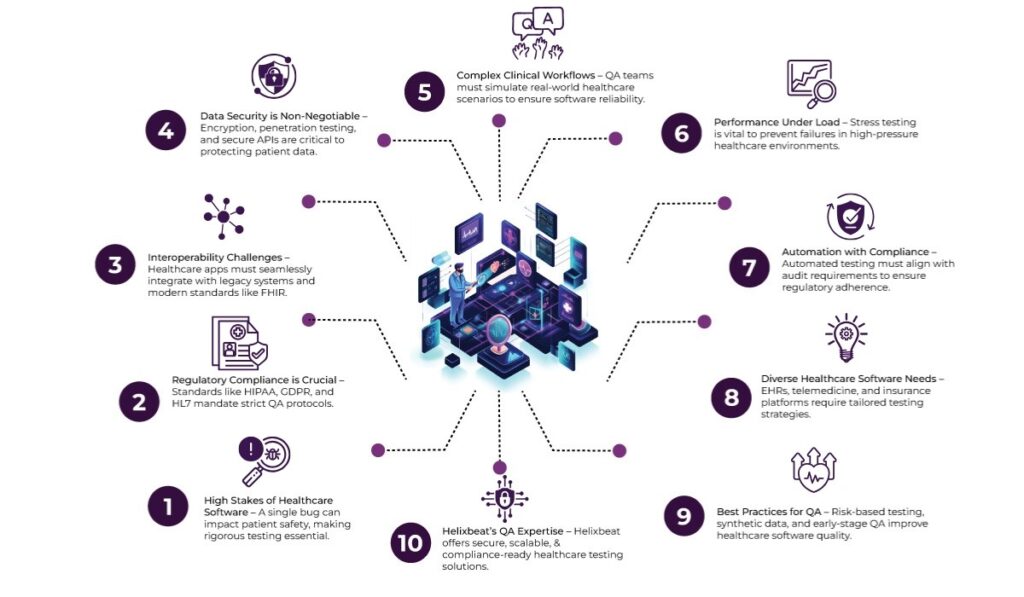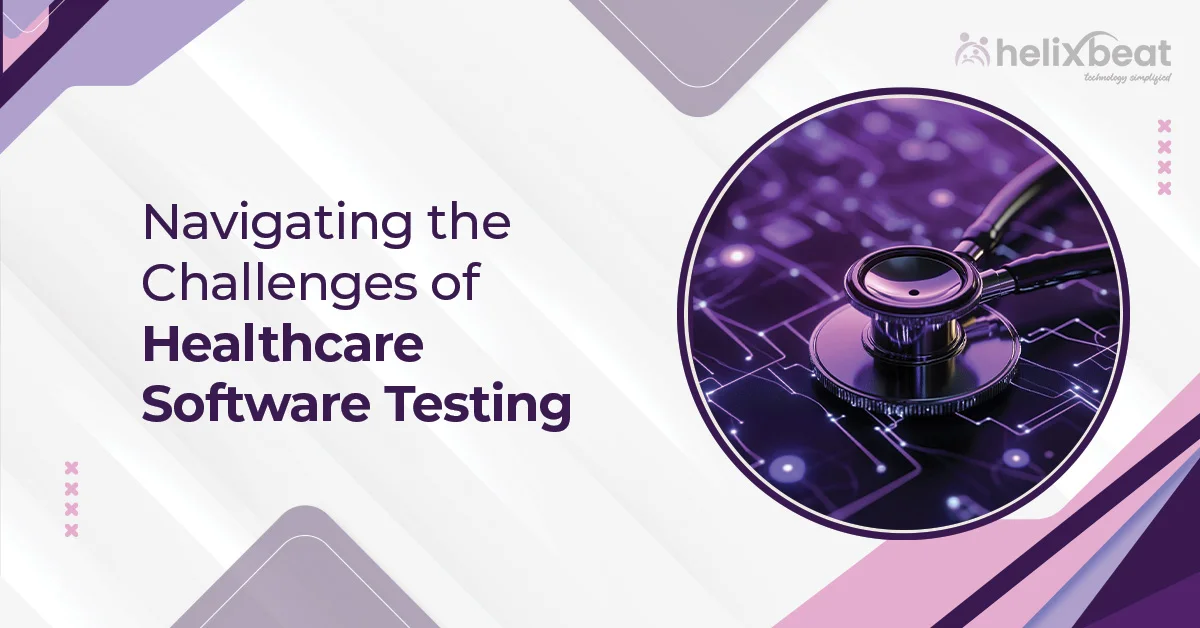Let’s consider this: a miscalculation in a finance app might result in a lost transaction, but a bug in a hospital’s EHR system could lead to a delayed diagnosis—or worse. That’s the unforgiving standard of healthcare software testing.
Healthcare software systems are highly scrutinized because they are used by doctors, nurses, pharmacists, insurance providers, and patients alike. A single flaw can disrupt workflows, delay critical treatments, or even compromise patient safety.
Moreover, the bar isn’t just high—it’s heavily regulated. Standards like HIPAA, HL7, GDPR, and other regional compliance mandates require healthcare applications to meet strict criteria. Therefore, testing healthcare software goes far beyond basic functionality. It demands rigorous validation of performance, data privacy, interoperability, security, and ethical responsibility.
Table of Contents
Understanding the Unique Nature of Software Testing in Healthcare
Testing healthcare applications requires a level of precision and responsibility that goes far beyond traditional QA. Here’s why:
1. Patient-Centric Stakes Are High
Healthcare platforms directly impact lives by managing sensitive patient records, treatment decisions, and medical workflows. A single bug could result in a misdiagnosis or delayed treatment. That’s why Healthcare Software Testing isn’t just about code—it’s about clinical safety and ethical responsibility.
2. Regulatory Compliance Is Non-Negotiable
Regulations shape every stage of software testing in healthcare. Compliance with standards such as HIPAA for data privacy, GDPR for user consent, and HL7/FHIR for interoperability is mandatory. Testers must document every step to demonstrate adherence to these strict frameworks—failure isn’t just costly; it’s illegal.
3. Integration with Legacy Systems
Hospitals often use outdated EHR systems. New applications must be tested for backward compatibility and seamless data exchange. QA teams need to simulate real-world scenarios to ensure interoperability across generations of software.
4. Data Security and Privacy Are Paramount
Breaches in healthcare carry high legal and reputational risks. Testing must include penetration testing, secure API evaluations, and encryption validation to protect patient data and maintain trust.
Major Challenges Faced in Healthcare Software Testing
Healthcare applications don’t just require functional accuracy—they demand real-world precision under pressure. Here are the key challenges testers navigate daily.
How Do Testers Tackle Real-World Clinical Complexity?
Healthcare workflows are rarely linear. A patient may interact with multiple specialists, receive several prescriptions, and go through multi-level insurance processes. Simulating such complex, interconnected workflows in a test environment is highly challenging. Effective Healthcare Software Testing requires QA engineers with deep domain knowledge who can anticipate various real-life patient journeys and edge cases.
How Can Testers Validate Interoperability?
One of the core pillars of software testing in healthcare is ensuring interoperability. Apps must communicate using standards like HL7 or FHIR. QA teams need to verify seamless data exchange without corruption or loss of format. This includes testing for different message types, real-time sync capabilities, and compliance with interoperability mandates.
Why Are Realistic Test Environments Critical?
Recreating hospital or clinical settings for QA is complex and resource intensive. Yet, realistic environments are vital for validating workflows under real-world constraints. Moreover, limited access to anonymized patient data often hampers comprehensive testing, reducing test reliability.
What Happens When Performance Fails Under Load?
Healthcare software must remain responsive even under peak conditions. A minor delay in ICU monitoring systems or prescription approvals can risk lives. That’s why load testing, stress testing, and failover simulations are essential parts of any Healthcare Software Testing strategy.
Key Types of Healthcare Software That Need Rigorous Testing
Healthcare technology is diverse, and each software type requires specialized testing strategies to meet clinical, operational, and regulatory standards.
Electronic Health Record (EHR) Systems must be validated for data accuracy, access control, and interoperability to ensure safe patient care.
Remote Patient Monitoring (RPM) Solutions demand precise data capture and real-time transmission testing to prevent diagnostic errors.
Clinical Decision Support Tools need extensive functional testing to validate algorithmic accuracy and minimize misdiagnosis.
Telemedicine Platforms must undergo performance and usability testing to deliver reliable remote care.
Insurance Claim Processing Portals require workflow testing to verify billing accuracy and compliance.
Pharmacy Inventory and POS Systems need integration testing to manage stock levels and ensure medication traceability.
Each system involves distinct Healthcare Software Testing protocols that align with clinical workflows, data privacy, and regulatory standards.
The Role of Automation in Healthcare QA
While automation accelerates test cycles, it must be applied thoughtfully in software testing in healthcare. Automated UI tests improve consistency across user journeys, and API automation helps validate HL7 and FHIR compliance. However, all test scripts must support traceability and version control to meet audit standards. Tools like Selenium, Postman, and JMeter are helpful, but automation frameworks must be audit-ready and aligned with strict compliance requirements to be effective.
How Helixbeat Solves Healthcare QA Challenges?
Helixbeat brings domain-specific expertise to the table through robust, customized Healthcare Software Testing solutions. Here’s how we make a difference:
1. Tailored Testing Strategies
We craft QA strategies based on your product type, target user personas, and specific compliance requirements. Whether you’re building a telehealth app or a claims processing platform, we adapt our testing architecture to suit your product’s unique needs.
2. Secure Automation Frameworks
Our team leverages encrypted test environments, secure scripting practices, and CI/CD-ready test pipelines, enabling your healthcare application to scale without compromising data integrity or compliance.
3. Compliance-Ready Documentation
All QA reports are prepared to meet audit standards. From HIPAA-compliant activity logs to GDPR consent trails, Helixbeat ensures your product stands up to real-world regulatory scrutiny.
4. Domain-Trained QA Teams
Our QA engineers are well-versed in healthcare standards such as HL7, FHIR, and ICD-10, as well as clinical workflows. This deep understanding enables us to catch domain-specific issues that others might miss.
5. Seamless Compatibility Testing
Whether your system runs on ICU-based iPads or integrates with cloud-based patient portals, we test across all devices, operating systems, and environments to guarantee optimal performance.
Best Practices for Testing Healthcare Applications
Effective Healthcare Software Testing goes beyond standard QA processes. It demands precision, compliance, and domain awareness at every step. Here’s how to approach it the right way:
1. Start Testing During Requirements Gathering
Shift-left testing introduces QA involvement early in the development cycle. Having testers present during requirements discussions helps uncover edge cases and regulatory considerations before code is written.
2. Use Synthetic Data with Realistic Scenarios
When conducting software testing in healthcare, privacy is paramount. Instead of real patient data, use synthetic datasets that accurately replicate real-world medical scenarios without violating HIPAA or GDPR standards.
3. Prioritize Test Cases Based on Risk
Focus testing efforts on high-risk workflows such as prescription processing, patient triage, or insurance claim submission. These areas carry higher stakes and require thorough validation.
4. Maintain Detailed Test Artifacts
Regulatory audits demand transparency. Keep comprehensive records of test cases, logs, and outcomes to demonstrate compliance and traceability.
5. Continuously Monitor Post-Deployment
Testing shouldn’t end at go-live. Monitor application behavior after release, especially following system updates, third-party integrations, or changes in regulatory requirements.
When Should You Choose a QA Partner Like Helixbeat?
Partnering with Helixbeat makes sense when:
- You’re preparing to launch in a regulated healthcare market
- Your existing QA team lacks specialized healthcare domain knowledge
- You need HIPAA or GDPR-compliant QA documentation
- Your application must integrate with legacy EHR systems
With Helixbeat’s QA testing services, you gain more than testers—you gain healthcare-focused technology partners committed to quality and compliance.
Final Words
Healthcare Software Testing isn’t just about identifying bugs—it’s about establishing trust in systems that support human lives.
With high-stakes workflows, strict compliance standards, and a rapidly evolving tech ecosystem, healthcare demands QA partners who deeply understand the industry. At Helixbeat, we bring that understanding to every engagement, focusing on precision, performance, and patient-centric functionality.
By choosing a testing partner like Helixbeat, you not only mitigate risks but also accelerate innovation in the healthcare space. Let us help you embed quality, security, and compliance into every line of your healthcare code—so you can deliver care with confidence.

FAQs
1. What is healthcare software testing?
It refers to the QA process focused on verifying that healthcare applications work correctly, comply with regulations, and protect sensitive data.
2. Why is software testing in healthcare critical?
Because bugs in healthcare apps can compromise patient safety, delay treatments, and lead to legal consequences.
3. What regulations should healthcare apps comply with?
HIPAA, HL7, FHIR, GDPR, and local health data laws, depending on the region.
4. What are common types of testing used in healthcare QA?
Functional, performance, security, compatibility, and compliance testing.
5. How is patient data handled during QA?
Testers use synthetic or anonymized data to protect real patient information.














